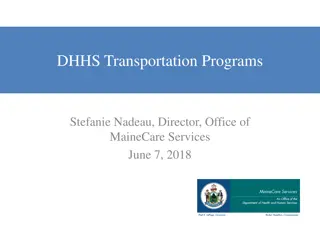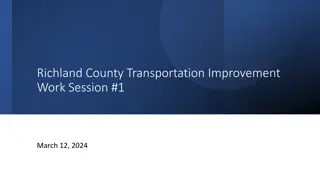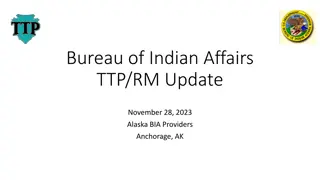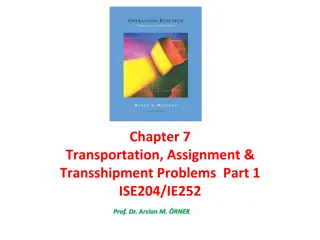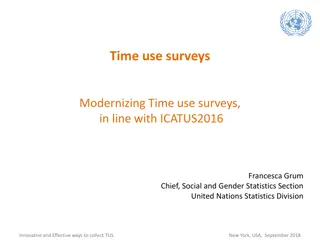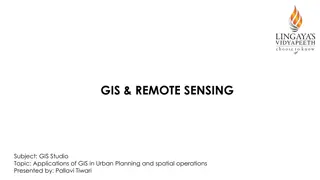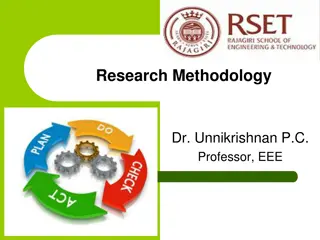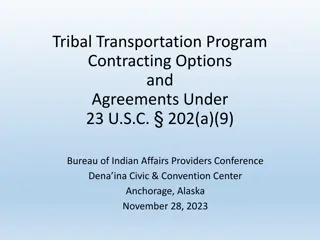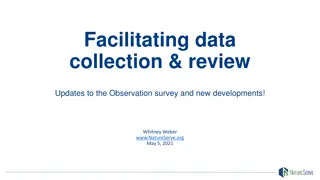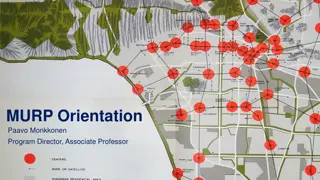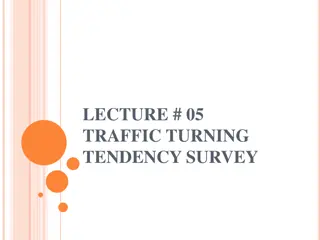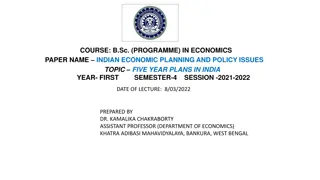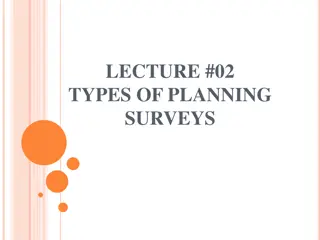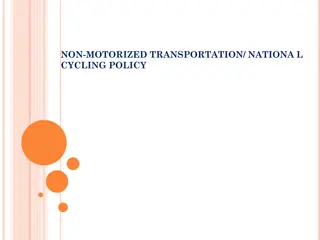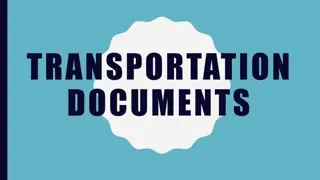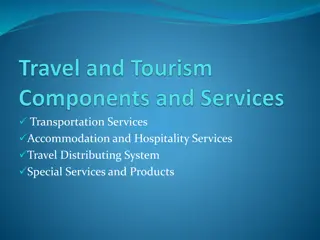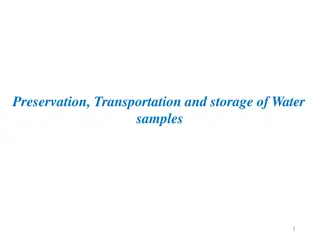Transportation Planning and Data Collection Insights
Understanding transportation planning involves various stages such as data collection, study area definition, and selection of external cordon lines. Collecting data on existing travel patterns, transport facilities, and land use is crucial for formulating effective transportation plans. Defining the study area and selecting the external cordon line carefully are essential steps in urban transportation studies.
Download Presentation

Please find below an Image/Link to download the presentation.
The content on the website is provided AS IS for your information and personal use only. It may not be sold, licensed, or shared on other websites without obtaining consent from the author. Download presentation by click this link. If you encounter any issues during the download, it is possible that the publisher has removed the file from their server.
E N D
Presentation Transcript
https://padlet.com/honiballjame s/nk7uxmsg02tv
Transportation survey, Data collection and Traffic Forecasting Part-1
Contents Collection of data Study area Zoning Type of surveys Attributes of a road system and road traffic Speed, delays and volume determination Travelling & trip speed Delays and volume studies Origin-destination studies Design volumes Forecasting Techniques
Collection of data The first stage in the formulation of a transportation plan is to collect data on all factors that are likely to influence travel pattern. The work involves a number of surveys so as to have an inventory of existing travel pattern, an inventory of existing transport facilities and an inventory of existing land use and economic activities. inventory of existing travel pattern inventory of existing transport facilities inventory of existing land use and economic activities
Definition of the Study Area The study area for which transportation facilities are being planned is first of all defined. Transportation planning can be at the national level, the regional level or at the urban level. For planning at the urban level, the study area should embrace the whole connurbation containing the existing and potential continuously up areas of the city. external cordon The imaginary line representing the boundary of the study area is termed as the 'external cordon'. The area inside the external cordon line determines the travel pattern to a large extent and as such it surveyed in great detail. The land-use pattern and the economic activities are studied intensively and detailed surveys (such as the home interview) are conducted in this area to determine the travel characteristics. On the other hand, the area outside the external cordon line is not studied in such detail.
selection of the external cordon line The selection of the external cordon line for an urban transportation study should be done carefully with due weightage to the following factors : The external cordon line should circumscribe all areas which are already built-up and those areas which are considered likely to be developed during the period of study. The external cordon line should contain all areas of systematic daily life of the people oriented towards the city centre and should in effect be the 'commuter-shed'. The external cordon line should be continuous and uniform in its course so that movements cross it only once. The line should intersect roads where it is safe and convenient to carry out traffic surveys. The external cordon line should be compatible with previous studies of the area or studies planned for the future
Zoning The defined study area is sub-divided into smaller areas called zones.
The purpose of such a sub-division is to facilitate the spatial quantification of land-use and economic factors which influence travel pattern. The data collected on individual household basis cannot be conveniently considered and analyzed unless they are aggregated into small zones which reflect the average characteristics of the individual households. coding A convenient system of coding of the zones will be useful for investigation Sub division into zones further helps in geographically associating the origins and destinations of travel. Zones within the study area are called internal zones and those outside the study area are called external zones. In large study projects, it is more convenient to divide the study area into sectors, which are sub-divided into smaller zones. Zones can themselves be sub-divided into sub-zones depending upon land-use.
Factors influencing Zoning Land-use is the most important factor in establishing zones for a transportation survey The zones should have a homogeneous land-use so as to reflect accurately the associated trip-making behaviour. Anticipated changes in land-use should be considered when sub-dividing the study area into zones It would be advantageous if the sub division follows closely that adopted by other bodies for data collection. This will facilitate correlation of data. The zones should not be too large to cause considerable errors in data. At the same time, they should not be too small either The zones should preferably have regular geometric form for easily determining the centroid which represents the origin and termination of travel.
Types of Surveys Internal to Internal Internal to External External to Internal External to External The surveys can collect the data At the home, During the trip and At the destination end of the trip. The following are some of the surveys that are usually carried out: Home interview surveys Commercial vehicle surveys Taxi surveys Road-side interview surveys Post card questionnaire surveys Registration number surveys Tag surveys. Public transport surveys. Use specific templates for specific survey kind of
Population of Study Area Under 50,000 50,000-150,000 150,000 300,000 300,000-500,000 500,000-1,000,000 Over 1,000,000 Standards for Sampling Size for Home Interview Surrey Sample Size 1 in 5 households 1 in 8 households 1 in 10 households 1 in 15 households 1 in 20 households 1 in 25 household
Public Transport Surveys In order to assess the number of bus passengers passing through an external cordon, the survey can either be by direct interview with the passengers or by issuing post- card questionnaires. Direct interview is likely to result in large delays and requires a large number of interviews. Post-card questionnaires eliminate such delays, but are likely to evoke poor response or contain an element of bias. Direct interview Post-card questionnaires external cordon rail survey An external cordon rail survey can be carried out by interviewing the passengers on trains. Alternatively, pre-paid questionnaires may be distributed to persons residing at stations outside the survey area. These questionnaires may also be collected at the stations inside the survey area pre-paid questionnaires
Inventory of Transport Facilities The inventory of existing transport facilities should be undertaken to identify the deficiencies in the present system and the extent to which they need to be improved. The inventory consists of: Inventory of streets forming the transport network Traffic volume, composition, peak and off-peak Studies on travel time by different modes Inventory of public transport buses Inventory of rail transport facilities Parking inventory Accident data.
Inventory of Land Use and Economic Activities Inventory of land use Since travel characteristics are closely related to the land-use pattern, it is of utmost importance that an accurate inventory of land-use be prepared. The zones are classified into land use activity such as residential, industrial, commercial, recreational open space and so on. For this purpose, the Town and Country Planning authorities need to be consulted. If any master plan has been prepared for the survey area, the same should be given due consideration. Aerial photography has also been used as a source of land-use data.
Inventory of economic activities Data on economic activities should be collected to include the following : Population of the survey area and the various zones Age, sex and composition of the family Employment statistics Housing statistics Income Vehicle ownership Expansion of Data from Samples In order to derive the travel characteristics of the whole population from the data derived from sampling, certain expansion factors have to be used. Where, A= Total number of addresses in the original list. B=Total number of addresses selected as original sample. C=Number of sample addresses that are ineligible. D=Number of sample addresses where no response is obtained. For the home-interview surveys, EXPANSION FACTOR is calculated on a zonal basis as follows : the expansion factor is
SPEED Speed is one of the most important characteristics of traffic and its measurement is a frequent necessity in traffic engineering studies. Speed is the rate of movement of traffic or of specified components of traffic and is expressed in metric units in kilometers per hour (K.P.H.). Spot speed Spot speed is the instantaneous speed of a vehicle at a specified location.
Running speed Running maintained by a vehicle over a given course while the vehicle is in motion. It is significant to note the clause 'while the vehicle is in motion', because the running speed is obtained by dividing the length of the course by the time the vehicle is in motion, i.e. by the running time, which excludes that part of the journey time when the vehicle suffers delay. speed is the average speed Running speed = Length of course /Running time = Length of course / Journey time - delay
Journey speed Journey speed, also known as overall travel speed, is the effective speed of a vehicle between two points, and is the distance between two points divided by the total time taken by the vehicle to complete the journey, including all delays incurred en-route. Journey speed = Distance / Total journey time(including delay) Time-mean speed Time-mean speed is the average of the speed measurements at one point in space over a period of the time. It is the average of a lumber of spot speed measurements. Space-mean speed Space-mean speed is the average of the speed measurements at in instant of time over a space.
Use of Speed, Journey Time and Delay Studies Spot speeds For geometric design of roads, it is necessary to have a realistic estimate of the speeds at which vehicles travel, Based on the speed studies, the design speed can be selected, and other geometric elements of design such as horizontal curvature, vertical profile, sight distances and super-elevation can be determined. For regulation and control of traffic operations, spot speed studies are needed. They enable the safe speed limits to be established and speed zoning to be determined. Traffic signal designs require speed data. Location and size of traffic signs are dependent upon speed. For analyzing the causes of accidents and identifying any relation between speed and accidents, spot speed data are needed, For before-and-after studies of road improvement schemes it is necessary to have spot speed data, enabling a meaningful analysis to be carried out of the effect of improvements, For determining the problems of congestion on roads and relating capacity with speeds, accurate speed data are useful
Journey speeds and delays The cost of a journey depends upon the speed at which it is made. In all highway economic studies, journey speeds and delays are highly important. Journey-time studies on a road net-work in a town are useful to evaluate congestion, capacity, level of service and the need for improvements. In transportation planning studies, the determination of the travel time is necessary for carrying out the trip assignment. Also, travel time and delays are some of the factors affecting modal choice. Before-and-after studies pertaining to journey time are useful for assessing the effectiveness of improvement measures. Delay studies at intersections provide data for the design and installation of the appropriate traffic control device cost of a journey evaluate congestion carrying out the trip assignment design and installation of the appropriate traffic control device assessing the effectiveness of improvement measures
Methods of Measuring Spot Speeds Those that require observation of the time taken by a vehicle to cover a known distance those in which vehicles are timed ever a long distance (long base), and those in which vehicles are timed over a short distance (short base). The long-base methods commonly used are : Direct timing procedure. Encscope Pressure contact tubes Radar speed meter which automatically records the instantaneous speed Photographic method
Recommended base lengths for spot speed survey Average Speed of traffic stream (K.P.H.) Base length (m) Less than 40 40 to 65 27 54 Greater than 65 81
Vehicle Volume One of the fundamental measures of traffic on a road system is the volume of traffic using the road in a given interval of time It is also termed as flow and is expressed in vehicles per hour or vehicles per day. When the traffic is composed of a number of types of vehicles, it is the normal practice to convert the flow into Equivalent passenger-car units (PCUs), by using certain equivalency factors. The flow is then expressed as PCUs per hour or PCUs per day.
Volume counts are indicators of the need to improve the transport facilities and are an invaluable tool in the hands of a transport Planner. Traffic Counts Levels of measurement of flow The three common levels of measurement of vehicle flow are : Average annual flow, expressed in vehicles per year, Annual Average Daily Traffic (AADT), expressed in vehicles per day. Hourly flow, expressed in vehicles per hour.
Method Available fur Traffic Counts The methods available for traffic counts are : Manual methods. Combination of manual and mechanical methods. Automatic devices. Moving observer method. Photographic methods.
Contd. to next part


